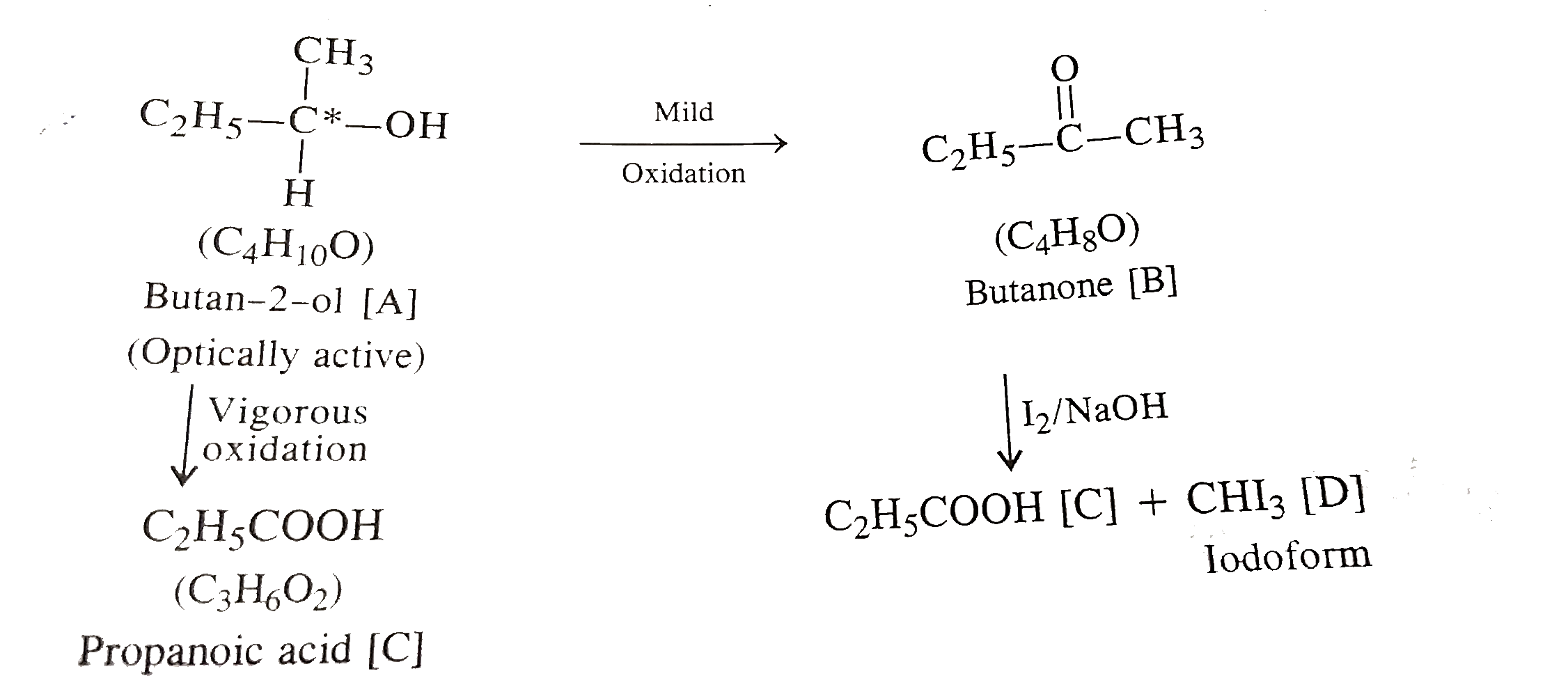An organic compound 'A'(C4H10O) is optically active. On mild oxidation, it gives a compound 'B'(C4H8O) but upon vigorous oxidation, it gives another compound 'C'(C3H6O2). The compound 'C' along with 'D' are also formed from 'B' by reacting with iodine in the presence of alkali. Deduce the structures of 'A','B','C' and 'D'.
The data suggests that the compound 'A' (C4H10O) is an alcohol. Since it is optically active in nature, it is a secondary alcohol. The alcohol upon mild oxidation gives ketone 'B'(C4H8O). The compound 'A' on vigouus oxidation forms an acid 'C'(C3H6O2). The acid 'C' and a compoun D (iodoform) are formed are when 'B' is reacted with iodine and alkali (NaOH). The sequenc of reactions is given ahead:

Similar Questions
A compound 'X' (C2H4O) on oxidation gives 'Y' (C2H4O2). The compound 'X' undergoes haloform reaction. Write the structure of 'X' and 'Y'.
View SolutionA compound (X) with the molecular formula C3H8O can be oxidized to another (Y) whose molecular formula is C3H6O2
The compound (X) may beView Solution
Knowledge Check
- Question 1 - Select One
Compound 'A' with the formula C3H8O on vigorous oxidation produces an acid C3H6O2. 'A' is
Aa tertiary alcoholBa secondary alcoholCa primary alcoholDnot necessarily an alcohol
An organic compound (A) (C8H14O) forms an oxime and gives a positive haloform reaction. On ozonolysis, it gives acetone and a compound (B) (C5H8O2) . (B) forms a dioxime and on subjecting to oxidation reaction gives an acid (C ) (C4H6O4). On treatment with excess of ammonia and strong heating, (C ) gives a neutral compound (D) (C4H5O2N). (D) on distillation with zinc dust forms pyrrloe. Suggest the possible structures of (A), (B), (C ), and (D). Explain the chemical reactions involved.
View SolutionAn organic compound (A) , C4H8Cl2 on hydrolysis forms another compound (B) , C4H8O.
If (B) does not responds to iodo form test , then identify possible structures of (A) and (B).View SolutionAn organic compound X(C4H8O2) gives positive test with NaOH and Phenopthalein. Structure of X will be:
View SolutionCompound X (C5H10O) is a chiral alcohol. It is catalytically hydrogenated to an achiral alcohol Y (C5H12O) and oxidized by activated MnO2 to an achiral carbonyl compound Z(C5H8O). Compound X is
View SolutionAn organic compound (A) , C4H8Cl2 on hydrolysis forms another compound (B) , C4H8O.
If all possible structures of (B) visualised above in (a) and (b) are treated with Zn - Hg/HCl , what are the products ?View SolutionCompound (A)(C8H12) on oxidation gives an acid B(C4H6O2). One mole of compound (A) reacts with 3mol of H2 in the presence of Pt catalyst to give octane. Identify compound (A).
View SolutionCompound (C9H10O) shows positive iodoform test. Oxidation of A with KMnO4/KOH gives acid B(C8H6O4) anhydride of B is used for the preparation of phenolphthalein compound is
View Solution

